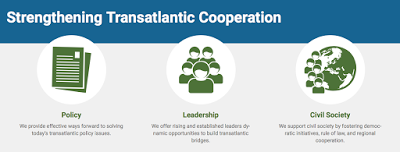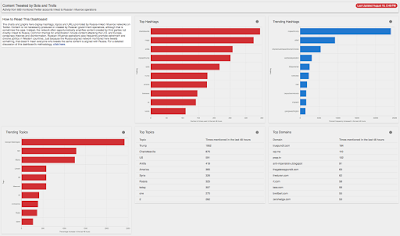
While so-called Russian “interference” and “disinformation” in the 2016 U.S. election has been pretty much headline news since July 2016, the means that are being taken to counter Russia’s “anti-democracy” moves have received relatively little coverage. Thanks to recent developments, German Marshall has now given us at least one hint about where the battle against Russian disinformation is headed.
For those of you that have never heard of the German Marshall Fund (GMF) (and I count myself among those), the organization’s aim is to:
“…strengthen transatlantic cooperation on regional, national, and global challenges and opportunities in the spirit of the Marshall Plan.”
This lofty goal will be accomplished as follows:
In case you’ve forgotten or were never aware of the Marshall Plan for which the group is named, it is also known as the European Recovery Program in which over $13 billion was channelled to Europe between 1948 and 1951 to finance the economic recovery of European nations after the significant damage that was done to the continent during the Second World War. The plan is names for Secretary of State George C. Marshall who announced the plan on June 5, 1947. Given recent history, it is interesting to note that while Americans viewed the Marshall Plan as a generous gift to Europe, the Soviet Union regarded it as an attempt to interfere in the internal affairs of other states and, as such, refused to participate.
As part of its mandate to strengthen transatlantic cooperation in early August, GMF announced the latest in its attempts to foil Russian disinformation with its Hamilton 68 Dashboard tool. Here is a quote from the announcement:
“In the Federalist Papers No. 68, Alexander Hamilton wrote of protecting America’s electoral process from foreign meddling. Today, we face foreign interference of a type Hamilton could scarcely have imagined.
Since Russia’s interference in the 2016 U.S. election, many have warned that Putin will be back in 2018 and 2020. But the reality is that Russian influence operations never left. As former Director of National Intelligence James Clapper recently stated, the Kremlin is already beginning to “prep the battlefield” for the 2018 elections. But what does this mean?
Russia’s activities continue on multiple fronts. One happening right under our nose and in plain sight is its continued information operations aimed at spreading propaganda and disinformation online. Indeed, Russia’s information operations in 2016 did not happen overnight — they were enabled by a foundation built over several years of operations in U.S. information space. Since the election, Russia’s efforts to shape what Americans think has continued. Americans deserve to know what messages Russian disinformation networks are pushing.
The Hamilton 68 dashboard, launching today as part of the Alliance for Securing Democracy, provides a near real-time look at Russian propaganda and disinformation efforts online. The top of the page shows tweets from official Russian propaganda outlets in English, and a short post discussing the themes of the day. This is Russia’s overt messaging.”
What the Hamilton 68 Dashboard does is monitor the activities of 600 Twitter accounts (none of which are identified) that are linked to online Russian influence efforts. While there is allegedly a clear connection between Russian influence and these particular accounts, GMF admits that not all of the accounts are directly controlled by Russia (i.e. Vladimir Putin). The users of these accounts are of three types:
1.) Accounts likely controlled by Russian government influence operations.
2.) Accounts for “patriotic” pro-Russia users that are loosely connected or unconnected to the Russian government, but which amplify themes promoted by Russian government media.
3.) Accounts for users who have been influenced by the first two groups and who are extremely active in amplifying Russian media themes. These users may or may not understand themselves to be part of a pro-Russian social network.
The 600 Twitter accounts in question are monitored in real time and look for the following types of content:
1.) Content generated by attributable Russian media and influence operations. This is a relatively small proportion of the network’s content. It includes, for example, content generated by RT (Russia Today) and Sputnik.
2.) Content amplified to reflect Russian influence themes. This content is typically produced by third parties, including but not limited to mainstream media, hyperpartisan sites and so-called “fake news” sites. Third-party content is sometimes amplified because it complements Russian influence themes. At other times, it is amplified for the opposite reason, meaning that users in the network are seeking to attack or discredit the content.
3.) Less relevant content. This includes popular hashtags, which the users employ to increase the reach of their messages, developing news stories, and (less commonly) random social dynamics in the network.
Here is a look at the dashboard showing the networks that are engaged in Russian-based disinformation:
The dashboard notes that the Twitter feeds that it tracks seek to:
“…amplify legitimate reporting when the content suits them, and they promote alternative media outlets that seemingly specialize in the production of disinfo, whether or not the outlets are controlled by the Kremlin. These outlets assemble stories from found objects – bits of information that may have some basis in reality. The final product will leap to conclusions the components of the story do not necessarily support, but which promote a distorted view of events to the Kremlin’s benefit.”
It is interesting to note that one of the top hashtags used by Russian-linked Twitter accounts is “Charlottesville” and that of the top ten topics in the last 48 hours, Charlottesville appears in the number two spot.
The whole point of this exercise is to “help ordinary people, journalists and other analysts identify Russian messaging themes and detect active disinformation or attack campaigns as soon as they begin. Exposing these messages will make information consumers more resilient and reduce the effectiveness of Russia’s attempts to influence Americans’ thinking, and deter this activity in the future by making it less effective.”
Fortunately for all of us, the German Marshall Fund is “not telling us what to think“, rather “they believe that should know when someone is trying to manipulate us“. At least we know that, in this time of the most overt Russian “aggression” since the end of the Cold War, GMF has our best interests at heart and is trying to prevent us from being manipulated. After all, last thing that the German Marshall Fund wants is to manipulate us, isn’t it?
Click HERE to view more.
You can publish this article on your website as long as you provide a link back to this page.



Be the first to comment